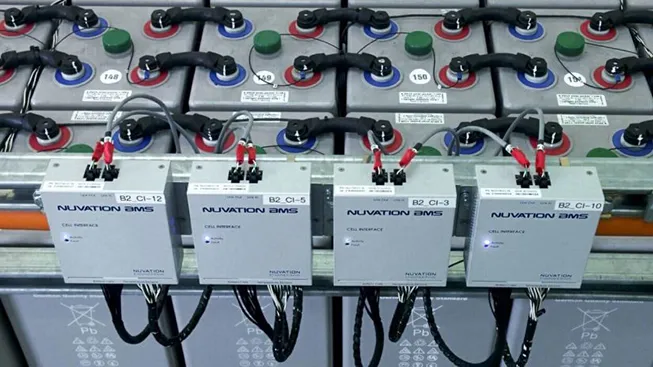September 30, 2019
Battery Management for Large-Scale Energy Storage (Part 4)
Part 4 of 4:
- State of Charge (SoC) and Depth of Discharge (DoD)
- Lead Acid Batteries and Battery Management
- Optimizing for Cycle Count
- Conclusion
State of Charge (SoC) and Depth of Discharge (DoD)
To avoid battery damage, most battery manufacturers recommend that their batteries never be fully discharged or fully charged. When setting SoC thresholds in the BMS to manage an energy storage system, system-level design considerations such as the PCS voltage requirements discussed earlier, and application-specific needs such as cycle count requirements are also factored in. The terms “full” and “empty” are therefore inaccurate in this context of “never completely full” and “never completely empty.” That’s why battery industry professionals instead prefer to use the term State of Charge (SoC) to refer to the degree to which a battery has approached the lowest or highest recommended level of charge; 100% SoC is not ‘full’ but is “as full as the system designers said we should go” and 0% SoC is not ‘empty’ but is “as empty as the system designers said we should go.” These thresholds are programmed into the battery management system where they are accessed by the PCS and used to prevent overcharging and over-discharging.
In Nuvation Energy’s battery management system, Depth of Discharge refers to how many amp-hours (Ah) of the total battery capacity have been used. The highest Ah reading on the DoD gauge in the BMS Operator Interface is the maximum DoD available. This enables a user to look at the Operator Interface to understand at a glance how much charge has been drawn from the battery and to determine how much is remaining.

How are SoC and DoD Measured by the BMS?
When a cell is rated by the manufacturer to be x amount of Volts, that cell actually fluctuates in voltage as part of its normal operation. The cell voltage is highest at 100% SoC and lowest at 0% SoC.
When a battery is at rest, i.e. there is no charge flowing through it, the BMS can determine the battery’s SoC based on its voltage alone. When a battery is being charged or discharged, however, calculating SoC becomes more challenging.
The voltage of a battery at rest is known as the “Open Circuit Voltage,” (OCV) because it represents the voltage of the battery when there is no circuit present carrying current. One way of measuring the SoC of a battery at rest is to compare the OCV to a data set provided by the battery manufacturer that shows the OCV of their batteries at different SoCs.
This data set is known as the “open circuit voltage curve” or the “OCV curve.” Batteries do not deplete or retain energy in a uniform manner as they move from full to empty or vice versa, hence the “curve.” This curve varies from chemistry to chemistry, so it is provided by the battery manufacturer.

Current flowing through the battery changes the voltage of the battery in a non-uniform manner. When the battery is in use, this phenomenon makes it very difficult to accurately calculate SoC by using voltage alone. Nuvation Energy’s battery management system adds a technique called coulomb counting to its approach to calculating SoC when a battery is in use. Coulomb counting measures the current flowing in or out of the cell.
The coulomb counting method integrates the measured current over time and factors in the battery capacity to update the SoC value. This algorithm requires an initial SoC value, which can be determined by conducting a full charge/discharge cycle. Unlike the OCV curve however, charge and discharge curves continually change as the battery is used, so charge-discharge cycle benchmarks are insufficient on their own to determine the SoC under current. Nuvation Energy’s battery management system has solved this problem with proprietary algorithms that also include additional sensor data.
Lead Acid Batteries and Battery Management
Lead-acid batteries can become damaged if overcharged and over-discharged during regular use (and even when deliberately overcharged during equalization). In the case of vented lead-acid batteries, overcharging can expel poisonous and flammable gases. Lead-acid cells as a whole tend to be less likely to catch fire than other chemistries, but some are still susceptible to thermal runaway.
Their reputation for resilience in the face of overcharging and over discharging, and their lack of a need for balancing has resulted in the misconception that lead-acid batteries do not need a BMS. While ‘need’ may be too strong word here, the lifespan of lead acid batteries can be dramatically reduced when the batteries are abused, and dramatically improved when managed by a BMS.
In an application with a small number of lead-acid cells, replacing a lead-acid battery from time to time may cost less than integrating a battery management system into the ESS. However, in a large-scale lead-acid energy storage system that outputs hundreds of kilowatt-hours or more of energy, the ROI of incorporating cell-level battery management becomes a simpler calculation, and developers of these systems tend to utilize a BMS.

There is also the use-case of battery backup systems and uninterrupted power supplies (UPS) where the battery is unused and in standby mode for 99% of its life and must be able to perform in the 1% use-case. The BMS used in this system can also track the health of the lead-acid battery backup to determine when a replacement is required. This enables pre-emptive maintenance or replacement before the next blackout occurs, and helps reduce routine maintenance visits.
Optimizing for Cycle Count
To meet the cycle count needs of their target customers, some battery manufacturers create charge/discharge ranges that are optimized to increase the total amount of cycles the battery can provide before being replaced. For example, a battery may be specified to only be discharged to 50% despite the fact that there is no likelihood of the cell being damaged anywhere above 15%. By defining such a partial cycle to the BMS as the nominal range of a full cycle, a battery manufacturer can provide a battery warrantied to support a higher cycle count.
In an emergency situation, this can present an opportunity if you have a BMS that integrates with your other ESS control systems in a manner that provides you with the flexibility to make different decisions. For example, during a protracted grid power failure you may wish to draw more charge from the battery at the expense of cycle count. Nuvation’s battery management system provides users with the ability to log into the BMS user interface and change the maximum DoD threshold settings within minutes in order to derive more capacity from the battery.
Alternately an emergency response function can be designed into the ESS control system by having SoC and DoD thresholds managed jointly by the BMS and the Energy Management System (EMS) or smart PCS. The BMS can manage battery safety and system-level operational thresholds, and the EMS or smart PCS can manage the more flexible parameters that address battery warranty / cycle count/ lifespan objectives. During typical ESS operation the EMS and / or smart PCS would respect the more flexible parameters while the BMS manages the safety limits. In an emergency situation the PCS can be instructed to draw additional charge within the flexible parameters while the BMS continues to enforce safety and system thresholds. This ‘collaboration’ across control systems can be designed into an ESS that uses a MESA conformant BMS by leveraging MESA to expose the required BMS-derived data to the PCS and EMS over Modbus TCP/IP (Ethernet).
Conclusion
We hope this exploration of battery management for large-scale energy storage provided you with some new knowledge and insights. As with most electronic equipment, all battery management systems are not created equal, and some perform their role better than others. When selecting a BMS important factors to consider include:
- How well does the BMS do its fundamental job of protecting batteries? A BMS uses a combination of sensor data and complex algorithms to derive the critical battery information used by numerous components in an energy storage system to prevent battery damage.
- How well does the BMS integrate with other components within and outside of the ESS that depend on receiving BMS data in real time to perform their functions effectively?
- How flexible is the BMS in terms of empowering users of the energy storage system to utilize the batteries in the manner they need and to respond to unexpected situations when they arise?
Nuvation Energy battery management systems are designed from the ground up for use in large-scale high-power applications and critical energy infrastructure. From initial ESS design, to systems integration, communications with internal and external control systems, and finally to being able to get what you need from your battery in any situation, Nuvation’s intelligent BMS has been designed with all of those tasks in mind. We are confident that when you evaluate our battery management systems, you will be very impressed. Contact Us today for a quote.

